In recent months, food delivery fees have been on the rise, and consumers are starting to feel the pinch. Whether you’re ordering from your favorite restaurant or using a third-party food delivery service, chances are you’ve noticed the increase in fees. But why are food delivery fees rising, and what impact is it having on consumers?
One of the main reasons for the rise in food delivery fees is the increasing costs associated with delivery services. From rising gas prices to the cost of hiring and retaining delivery drivers, food delivery companies are facing mounting expenses that are being passed on to consumers. In order to remain competitive and profitable, many companies have no choice but to raise their fees.
Another factor contributing to the increase in food delivery fees is the growing popularity of food delivery services. As more and more people opt for the convenience of having their favorite meals delivered to their doorstep, demand for these services has surged. This increased demand has allowed food delivery companies to raise their prices without fear of losing customers.
So how are consumers reacting to the rise in food delivery fees? Many are feeling frustrated and are starting to rethink their reliance on food delivery services. For some, the increased fees are making it less affordable to order in, leading them to cook at home more often or dine out at restaurants instead. Others are choosing to opt for pickup options or look for deals and discounts to offset the higher costs.
For those who rely on food delivery services due to busy schedules or limited mobility, the rising fees can be particularly burdensome. Some consumers are calling for more transparency around fees and pricing, as well as for companies to offer more affordable options for those who may be struggling to afford the higher costs.
In response to the backlash, some food delivery companies are exploring ways to mitigate the impact of rising fees on consumers. This includes offering subscription services that provide discounts on delivery fees, partnering with restaurants to offer exclusive deals, and implementing dynamic pricing based on demand and delivery distance.
Ultimately, the rise in food delivery fees is a reflection of the changing landscape of the food industry and the increasing demands of consumers for convenience and flexibility. While the higher costs may be challenging for some, it’s clear that food delivery services are here to stay and will continue to play a major role in how we eat and dine in the future. Consumers may need to adjust their expectations and budgets accordingly, but with some creativity and savvy shopping, it’s still possible to enjoy the convenience of food delivery without breaking the bank.
